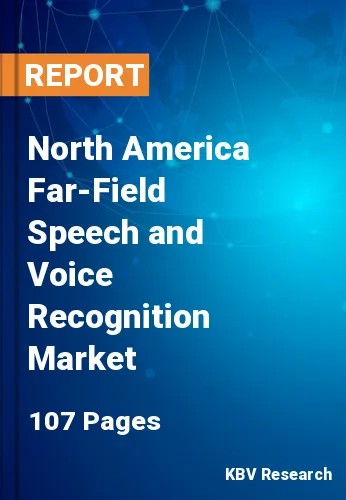The North America Far-Field Speech and Voice Recognition Market would witness market growth of 12.5% CAGR during the forecast period (2023-2030).
The advancement of deep-learning-based far-field microphone technology and the rising influence of front-end hardware components on the accuracy of speech and voice recognition are the main reasons propelling the market. The need for far-field speech and voice recognition is expanding due to the rising demand for voice-activated smart speakers and the technology's increasing significance for speech communications by enabling smart devices to recognize far-off human speech.
The use of the technology in several contexts, including smart home appliances, meeting transcription, onboard navigation, and the gathering of speech signals for far-field speech recognition, as well as the use of microphones to do so, have a significant impact on the market. The demand is also favorably impacted by the adoption of cutting-edge technologies, research and development activities, and increased investment. Players in the market will have lucrative possibilities during the forecast period due to the implementation of far-field speech and voice recognition in smart home devices and the use of speech and voice recognition in service robots.
The US Energy Information Administration estimates that in 2021, the typical family in the US used 97.33 quadrillion BTUs of energy, with a considerable amount of the energy going to waste. In 2019, the typical home used energy that contributed to 17,320 lbs of CO2 emission. To put this figure in perspective, consider that the average home produces 70% more CO2 emissions yearly than the typical passenger car. These situations cater to the need for smart home solutions. Smart speakers are also necessary because they offer a brand-new interactive digital endpoint in the house to which more than one-third of US consumers currently have access. Market leaders like Amazon and Google may use this digital endpoint to create speech apps for third parties. The far-field and speech recognition market is expected to increase significantly due to all these factors.
The US market dominated the North America Far-Field Speech and Voice Recognition Market by Country in 2022, and would continue to be a dominant market till 2030; thereby, achieving a market value of $2,185.8 million by 2030. The Canada market is poised to grow at a CAGR of 15% during (2023 - 2030). Additionally, The Mexico market would witness a CAGR of 14% during (2023 - 2030).
Based on Offering, the market is segmented into Digital Signal Processors, Microphone (Circular Arrays, Single Arrays, and Single Microphone) and Software. Based on Application, the market is segmented into Smart Speakers, Smart TV/STB, Automotive, Robotics and Others. Based on countries, the market is segmented into U.S., Mexico, Canada, and Rest of North America.
Free Valuable Insights: The Worldwide Far-Field Speech and Voice Recognition Market is Projected to reach USD 9 Billion by 2030, at a CAGR of 13.8%
The market research report covers the analysis of key stake holders of the market. Key companies profiled in the report include Andrea Electronics Corporation, Qualcomm, Inc., Cirrus Logic, Inc., Knowles Corporation, Harman International Industries, Inc. (Samsung Electronics Co., Ltd.), Infineon Technologies AG, Microchip Technology Incorporated, NXP Semiconductors N.V., STMicroelectronics N.V. and Synaptics Incorporated.
By Offering
By Application
By Country
Our team of dedicated experts can provide you with attractive expansion opportunities for your business.

